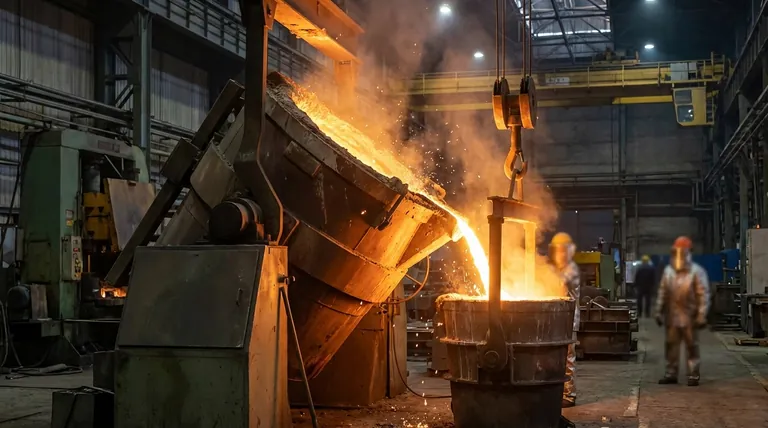In short, a tilting furnace can melt virtually any metal, from aluminum and copper to steel, iron, and even high-temperature precious metals like platinum. The term "tilting furnace" describes the mechanical function of pouring, not the heating method, so the specific metals you can melt depend entirely on the furnace's underlying heating technology and maximum temperature rating.
The critical takeaway is not which metals a tilting furnace can melt, but rather that the tilting mechanism is paired with a specific heating system (like induction or resistance). You must match that system's temperature capabilities to the melting point of your target metal.

What a "Tilting Furnace" Really Means
Many people confuse the tilting feature with the furnace type itself. Understanding this distinction is the first step to making an informed decision.
A Mechanism for Pouring, Not Melting
A tilting furnace is simply any furnace mounted on a pivot system that allows the entire structure to be tilted.
This design provides a safe, controlled, and efficient way to pour large quantities of molten metal directly from the furnace crucible into a ladle or mold, which is essential in foundry and industrial settings.
Paired with Different Heating Technologies
The tilting mechanism can be applied to several types of furnaces. The most common is the induction tilting furnace, which is praised for its speed, energy efficiency, and clean melting process.
Other types, such as electric arc and resistance furnaces, can also be designed to tilt. The heating technology inside the furnace is what dictates its performance and the metals it can handle.
Metals Commonly Melted in Tilting Furnaces
Because tilting is a feature, the list of compatible metals is extensive. We can group them by their type and the furnace requirements.
Ferrous Metals (Iron-Based)
Tilting furnaces, particularly induction and arc furnaces, are the standard for melting ferrous metals. Their robust construction and high-power capabilities are ideal for this work.
This category includes:
- Iron and Steel
- Stainless Steel
- Ferroalloys and recycled alloyed scrap
Non-Ferrous Metals
Non-ferrous metals are widely melted in tilting induction furnaces due to the clean energy transfer and precise temperature control that induction provides.
Common examples include:
- Aluminum and its alloys
- Copper
- Brass
- Zinc
Precious and Refractory Metals
Specialized, high-frequency induction tilting furnaces are used for metals with very high melting points or those requiring extreme purity.
These furnaces can reach temperatures over 2100°C in minutes, making them suitable for:
- Gold and Silver
- Platinum and Platinum Group Elements (PGEs)
- Other refractory metals that resist heat
Understanding the Key Trade-offs
You cannot use just any tilting furnace for any metal. The decision is governed by fundamental technical limitations.
Temperature Capability is Critical
This is the most important factor. A furnace designed to melt aluminum (melting point ~660°C / 1220°F) will be completely ineffective for melting steel (melting point ~1370°C / 2500°F).
Always verify that the furnace's maximum operating temperature is well above the melting point of your intended metal.
Cleanliness and Contamination
The melting method impacts the final quality of the metal. Induction furnaces are favored for high-purity alloys and precious metals because the heating process is non-contact and does not introduce impurities from combustion byproducts.
This "clean melt" is crucial for applications in aerospace, medical, and jewelry manufacturing.
Energy Efficiency and Melt Speed
Modern induction tilting furnaces offer significant advantages in energy efficiency and melt speed compared to older fuel-fired methods.
The ability to melt a full crucible of platinum in minutes, for example, dramatically increases production efficiency and reduces energy costs per cycle.
Making the Right Choice for Your Application
To select the correct equipment, start with your goal and work backward to the required technology.
- If your primary focus is large-scale industrial production of steel and iron: A high-power induction or electric arc tilting furnace is the industry standard for its capacity and efficiency.
- If your primary focus is melting aluminum, copper, or brass for casting: A standard-frequency induction tilting furnace offers the best combination of speed, control, and cleanliness.
- If your primary focus is high-value precious or refractory metals: You must invest in a specialized, high-temperature induction tilting furnace designed for purity and rapid heating cycles.
Ultimately, choosing the right furnace begins with understanding that its heating technology, not its ability to tilt, defines its true capabilities.
Summary Table:
| Metal Category | Common Examples | Key Furnace Requirement |
|---|---|---|
| Ferrous Metals | Iron, Steel, Stainless Steel | High-power induction or arc furnace |
| Non-Ferrous Metals | Aluminum, Copper, Brass | Standard induction furnace for speed & control |
| Precious/Refractory Metals | Gold, Platinum, PGEs | High-temperature, high-frequency induction furnace |
Ready to find the perfect tilting furnace for your specific metals?
At KINTEK, we specialize in providing the right lab equipment for your unique needs. Whether you're melting aluminum, steel, or high-purity platinum, our experts will help you select a tilting furnace with the precise heating technology and temperature capabilities for maximum efficiency, purity, and performance.
Contact our specialists today for a personalized consultation and let KINTEK be your partner in precision melting.
Visual Guide

Related Products
- Laboratory Vacuum Tilt Rotary Tube Furnace Rotating Tube Furnace
- Vacuum Heat Treat Furnace and Levitation Induction Melting Furnace
- Rotary Tube Furnace Split Multi Heating Zone Rotating Tube Furnace
- Laboratory Muffle Oven Furnace Bottom Lifting Muffle Furnace
- 1400℃ Laboratory Quartz Tube Furnace with Alumina Tube Tubular Furnace
People Also Ask
- What is the process of zirconium production? From Ore to High-Performance Metal & Ceramic
- What are the advantages and disadvantages of rotary furnace? Maximize Uniformity & Efficiency in Thermal Processing
- What are the advantages of a rotary furnace? Achieve Superior Homogeneity & Efficiency for Powders & Granules
- What is a rotary heat type furnace? The Ultimate Guide to Uniform Heating & Mixing
- How are tube furnaces classified based on the orientation of the tube? Choose the Right Design for Your Process



















